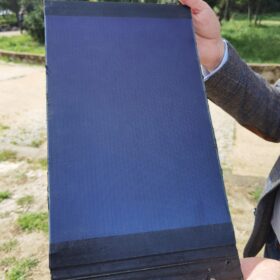A European consortium led by EDP New has set out to demonstrate that historical cities can also benefit from solar energy. As part of the Pocityf project, 46 partners have been developing BIPV solutions to blend into the landscape of historical sites in the pilot cities of Évora, Portugal, and Alkmaar, Netherlands. The cities of Granada (Spain), Celje (Slovenia), Bari (Italy), Ioannina (Greece), Upjest (Hungary), and Hvidovre (Denmark) will follow suit.
“The fact that we are focused on historic cities means that we have added challenges, with legal barriers to changing the existing architecture,” Júlia Pereira, project coordinator for EDP New, told pv magazine. “All the solutions are designed so that the aesthetics of the city are not altered, but still manage to rejuvenate the historic centers.”
Évora’s historical center is part of UNESCO’s World Heritage List and is hence covered by special protection and conservation rules. Over 40 BIPV solutions will be implemented in Évora in the next months, all of which have been designed to blend into the existing buildings and structures.
These include classic terracotta PV roof tiles from Italy-based Tegosolar. Dyaqua, an Italian solar start-up, manufactures the so-called “invisible solar” solution by covering monocrystalline silicon cells with a surface that is opaque at the sight but translucent to sun rays. Around 3,350 PV roof tiles will be installed on the rooftop of Evora’s town hall, with a total installed capacity of 25,36 kW. Each roof tile has an output of 7,57 W and an efficiency of 7.80%.
Procurement of the PV roof tiles wasn’t an easy task, according to Pereira. Their production is still happening on a small scale which hinders profitability.
“The price per kW is €7,000 ($7,605),” she said. “The roof tiles took six months to be manufactured and are now ready for installation, which will happen between June and August this year.”

Image: Câmara Municipal de Évora
Other solutions include amorphous-silicon photovoltaic glass from Spain-based BIPV specialist Onyx Solar. The colorful see-through solutions were architects’ top choice to replace skylights and windows in municipal buildings, markets, and schools. The skylight of Évora’s municipal market, for example, will feature 74 units with an output of 236 W each. Their efficiency ranges from 2.8% to 5.76%. The installation will cover 124,49 square meters and include glasses of five different dimensions.
The project is also implementing BIPV solutions that haven’t yet reached commercialization. “We are developing economic models that can make these solutions viable for commercialization after this project,” Pereira added.
Évora’s historical center residents are reportedly open to installing the BIPV solutions, despite their lower efficiency and higher price than standard rooftop PV.
“Our expectation, for now, is that these solutions can be a reality within the historic center, and in the near future, that the residents themselves can also have access to this type of solution,” Nuno Bilo, mechanical engineer at Évora’s city hall told pv magazine. “The feedback we have from residents is that regardless of the efficiency of the tiles, they are interested in installing these BIPV solutions – it is better to have this than nothing.”
To facilitate citizen engagement in and outside the city’s historical center, the Pocityf project also includes peer-to-peer energy trading, collective self-consumption for municipal buildings, and a platform where private citizens can register to sell or buy self-produced electricity.
The city hall is also drafting a tender for the concession of a community solar farm in Évora. The winning bidder should develop renewable energy on public land while guaranteeing a price per kWh lower than the spot market for citizens living in the historic center of Évora.
The Pocityf project started in October 2019 and is due to end in June 2025.

Image: Câmara Municipal de Évora

Image: Câmara Municipal de Évora
This content is protected by copyright and may not be reused. If you want to cooperate with us and would like to reuse some of our content, please contact: editors@pv-magazine.com.



This article sparks such a fascinating vision! Imagine, centuries-old facades subtly transforming into power generators, seamlessly blending heritage with cutting-edge tech. It’s like whispering a modern secret to ancient stones. I wonder, though, how we ensure these delicate integrations not only preserve the historical narrative but also become a vibrant part of the city’s living, evolving story.